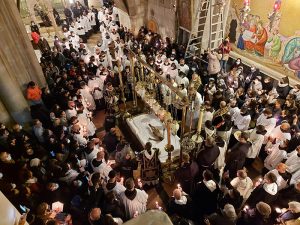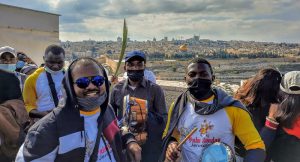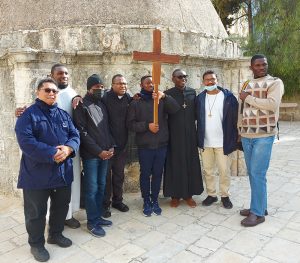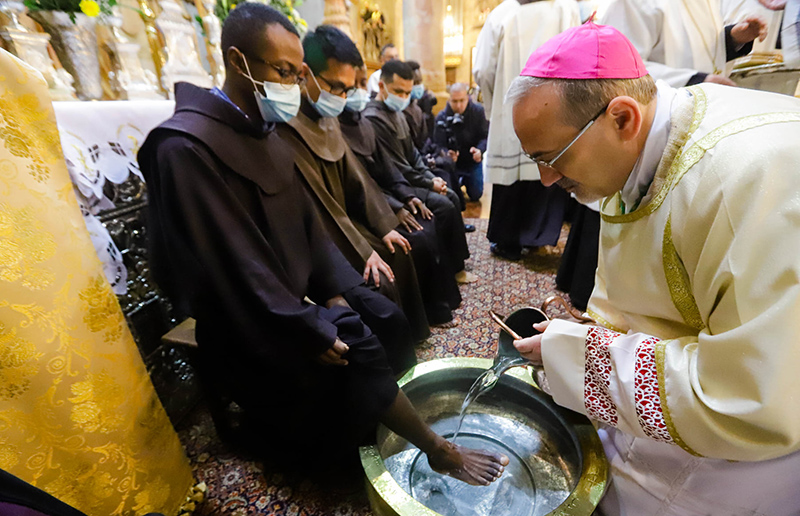The celebrations of the Holy Week in the Holy Land have got a special tone, given that they happen in the land and in the place where Jesus walked. Just like the rest of the Latin catholic world, in Jerusalem too, the Holy Week starts with the Palm Sunday celebrations. However some events make it special, for example the vigil with Jesus in the Garden of Gethsemane, the funeral procession and many more you will never see anywhere else, as this article will bring to our attention.
On Palm Sunday, the Holy Eucharist was celebrated at the Basilica of the Holy Sepulchre by the Latin Patriarch His Beatitude Pierbattista Pizzaballa OFM, in the morning hours of the day. The faithful of different denominations, especially from the western tradition, that’s to say Latin Catholics, Protestants, Anglicans, Lutherans and other communities together with their leaders met at Bethpage to relive the triumphant entry of Jesus into Jerusalem. Among the congregants were the Latin Patriarch himself who led the procession, the Papal Apostolic Nuncio, Lutheran and protestant bishops, priests, religious and the local faithful. The number was restricted due to the corona virus pandemic, as people were asked to move in groups of 50, which I can say was hardly respected.
In the Gospel of Luke 19:29-40, we read, “As he drew near Bethpage and Bethany at the place called Mount of Olives, he sent two of his disciples. He said, “Go in the village opposite you, and as you enter it, you will find a colt (donkey) tethered on which no one has ever sat. Untie it and bring it here. If anyone should ask you, why are you untying it? You will answer ‘the master is in need of it”. So from Bethpage Jesus sat on the donkey and began his triumphant journey to enter Jerusalem. From 2:30 pm with songs of joy, drums, bells, Christians left Bethpage climbed the Mount of Olives and then descended on to Jerusalem up to the “Lion’s gate” through which Jesus entered. Today it is closed by the Muslims to stop the Messiah, who should come from the east, from coming as the Jews are still waiting for the Messiah. The place is owned by the Muslims, who built a mosque on the Temple Mount and on the Holy of Holies where the second Jewish temple stood, the Dom of the Rock.
On the journey a stopover was made at “Dominus Flevit” for prayer, the place where Jesus wept on Jerusalem foreseeing its destruction. The conclusion of Jesus’ triumphant journey into Jerusalem, which originally takes place at the “St Anna”, where Mary is believed to have been born, this year because of the pandemic, took place at the entrance of the old city at the Lion’s gate with an apostolic blessing of the Latin Patriarch.
Six days before the Passover, Jesus went to Bethany, where Lazarus was, whom he had raised from the dead. They gave a dinner for him there; Martha waited on them and Lazarus was among those at the table. The gospel of John tells us that while they were at the table, Mary brought in a pound of costly ointment and anointed Jesus’ feet. So as a tradition is kept by the Franciscans who are custodians of the holy places in the holy land, on Monday we went to Bethany with a group of different religious people. The Custos of the Holy Land, Father Francesco Patton, OFM led a Eucharistic celebration followed by the ointing of all participants of the ceremony to recall what Mary had done to Jesus.
On Holy Thursday the Latin patriarch of Jerusalem celebrated the Chrism Mass in the morning at the basilica of the Holy Sepulchre. However again in Jerusalem, there is something special that happens here, the “Cena Domini Mass”, which elsewhere takes place in the evening, in Jerusalem all is done at the same time because of the status-quo signed in the 18th century and confirmed and re-confirmed during the 19th century by the Ottoman empire for the use of the Holy places by the different churches in Jerusalem and in the Holy Land. In his homily, the Patriarch His Beatitude Pizzaballa elaborated on the sacramental dimension of the Church, “this celebration is not only a reminder of the last supper and ministerial priesthood but also of the common priesthood rooted in baptism”. The celebration was concluded by the procession of the Blessed Sacrament.
Later on the same day at 9:00 pm was the vigil at Gethsemane were the Lord went to pray after the Passover and then was arrested. It is also known as the Holy hour. Vigil prayers presided over by the Custos of the Holy Land were celebrated and then a moment of prayer at the stone where Jesus sweat blood, which is just in front of the altar in the “Church of all nations”, located in the garden of Gethsemane. The evening was concluded by a procession from the garden of Gethsemane through the Kidron valley to “St Peter Gallicantu church” where Peter denied Jesus. After his arrest, Jesus was brought to this place.
The next day, which is Good Friday, began with the Via Crucis. From the main way of the cross, led by the Custos of the Holy Land, various groups also led their own way of the cross, Catholics but also those of different denominations and communities. The passion of the Lord was celebrated in the Holy Sepulchre by the Latin Patriarch. Later in the evening a funeral procession was held in the basilica of the Holy Sepulchre presided over by the Custos of the Holy Land. This procession began from the small chapel of the Franciscans, went around to the Calvary, down to the stone of anointment where the body of the Lord was anointed before it was laid in the Holy Sepulchre. The passion narrative was being read at different moments and in different languages.
Differently from the rest of the Latin catholic world, the Pascal vigil in Jerusalem takes place in the morning hours of Holy Saturday to keep the status quo. “It is the first Easter vigil in the world, and it is considered the mother of all vigils”, said the patriarch in his homily. “Do not fear, look ahead, be joyful, Christ has conquered death” he added. At the end of the celebration, all the faithful of Jerusalem could witness that Christ is risen, he is alive Alleluia.
The Holy week celebrations were concluded with the walk to Emmaus, 40 km west of Jerusalem in which some of our confreres participated. The journey full of life, sharing, singing took almost 8 hours and was concluded by a Eucharistic celebration of the manifestation of the Risen Lord presided over by the Custos of the Holy Land. Just like it is for the Christmas celebrations, the Easter celebration may well be over for Latin Catholics and other western churches and communities, but for the Eastern Catholics and Orthodox churches, “Easter” will be on 2nd May. Our Easter also this year had something special as it coincided with the Jewish Passover. So Jerusalem was full of celebration as Christians and Jews met in the streets of the old city, some (Christians) going to the Holy Sepulchre and others (Jews) to the western wall or the Wall of Lamentations to relive these important life changing events in the history of humanity.
Henry Ssemakula and confreres in Jerusalem.




